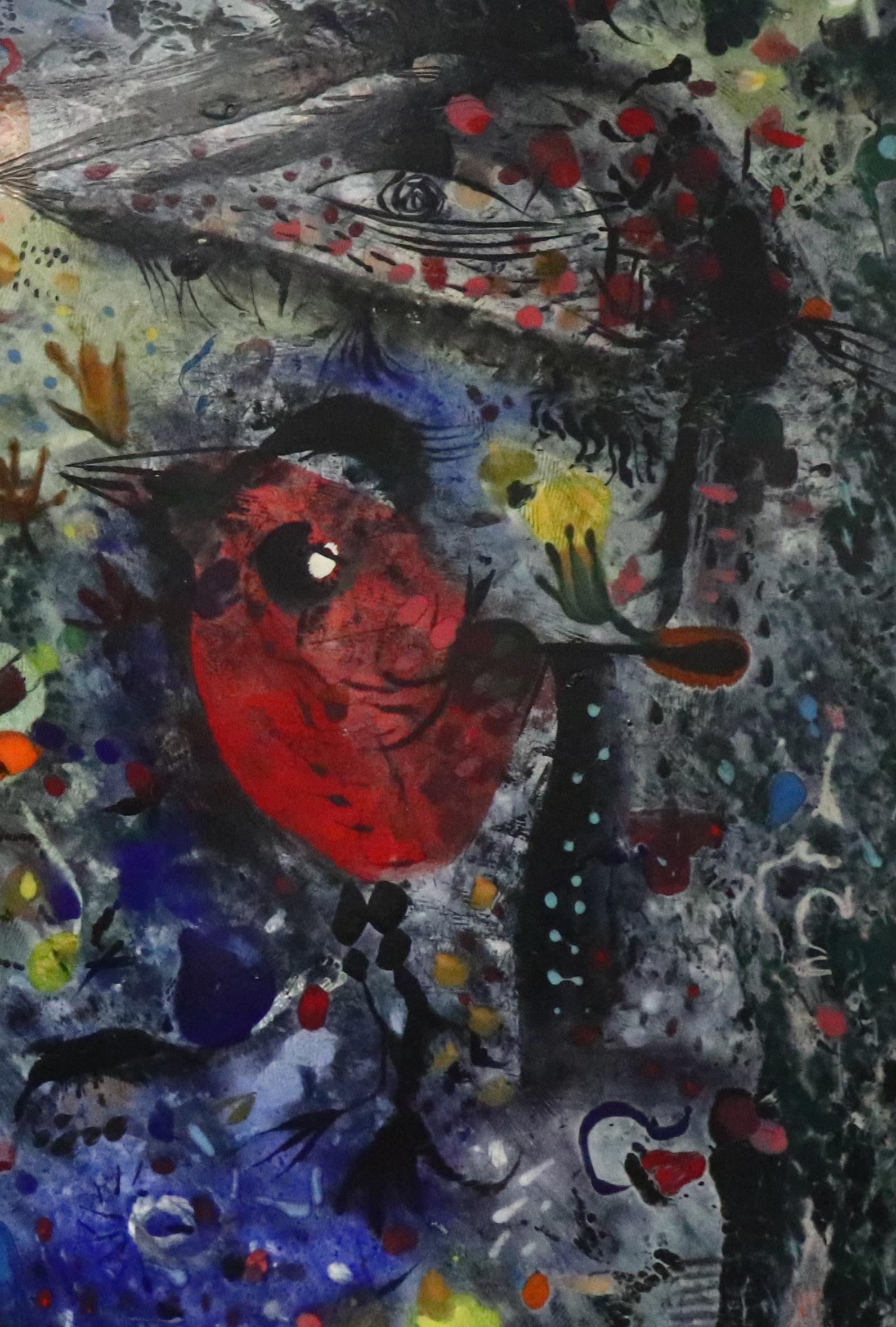
The Art Collection of St Hilda’s College
The University of Melbourne 2024


The Art Collection of St Hilda’s College
The University of Melbourne 2024
Pascalle Bailey multidisciplinary artist and writer based in Melbourne. A graduate of Master of Curatorship at the University of Melbourne, Pascalle has primarily worked in collections housed in close-knit communities, often related to fields of education. Pascalle spent 10 months cataloguing the St Hilda's collection through careful analysis of records, letters and meeting minutes, as well as the works themselves. The final result of this is Creating Communitas, published in 2024 in celebration of the College's 60th anniversary.
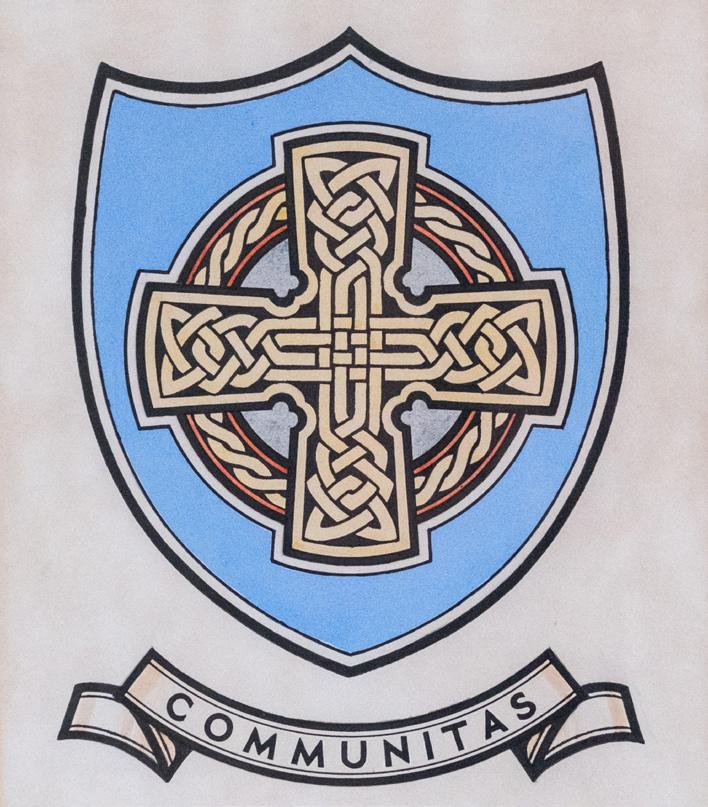

Many academic collections begin under the premise of serving as a visual signifier of the institutions that house them, showcasing their virtues of culture, morality and prosperity. St Hilda’s was not one such institution. St Hilda’s was borne through a long-running, hard-fought campaign, spearheaded by a select few, very determined women. It was then through these women that the very first items of the collection emerged. The purpose here was very simple; they wanted to create a space that felt like home, a place where young women could take refuge as they embark on their journey through tertiary education. We have very little record of who donated these early works simply because they felt there was no great significance in what they were doing; their actions were second nature. This instinct for home-building formed the foundation of Communitas, and as a result the collection grew.
Subconsciously, the works entering the collection reflected the values of the college, presenting works made by underrepresented artists, women, and indigenous creatives, often donated by those within the Hilda’s community. Recognizing the importance of Indigenous Australians within the wider history of the College and the land it resides on has become a significant priority to the St Hilda’s community, which has been reflected in the College’s recent acquisitions.
More recent additions to the collection have included commissions by the students themselves, that provide a more personal reflection of the College by those that live within its walls.
The first visual signifier of the college came in the design of the St Hilda’s crest. In many ways, this work is the first in the Art Collection of the College. The crest of St Hilda’s was borne through careful negotiation, with discussions beginning some time before builders broke ground in Parkville. The final design was accepted in 1967. The crest, much like the College’s name, sought to express a sense of unification and neutrality, in acknowledgement of the two churches at the College’s foundation. The phrase “Communitas” is emblazoned at the base of the crest, demonstrating its presence as the bedrock of St Hilda’s.
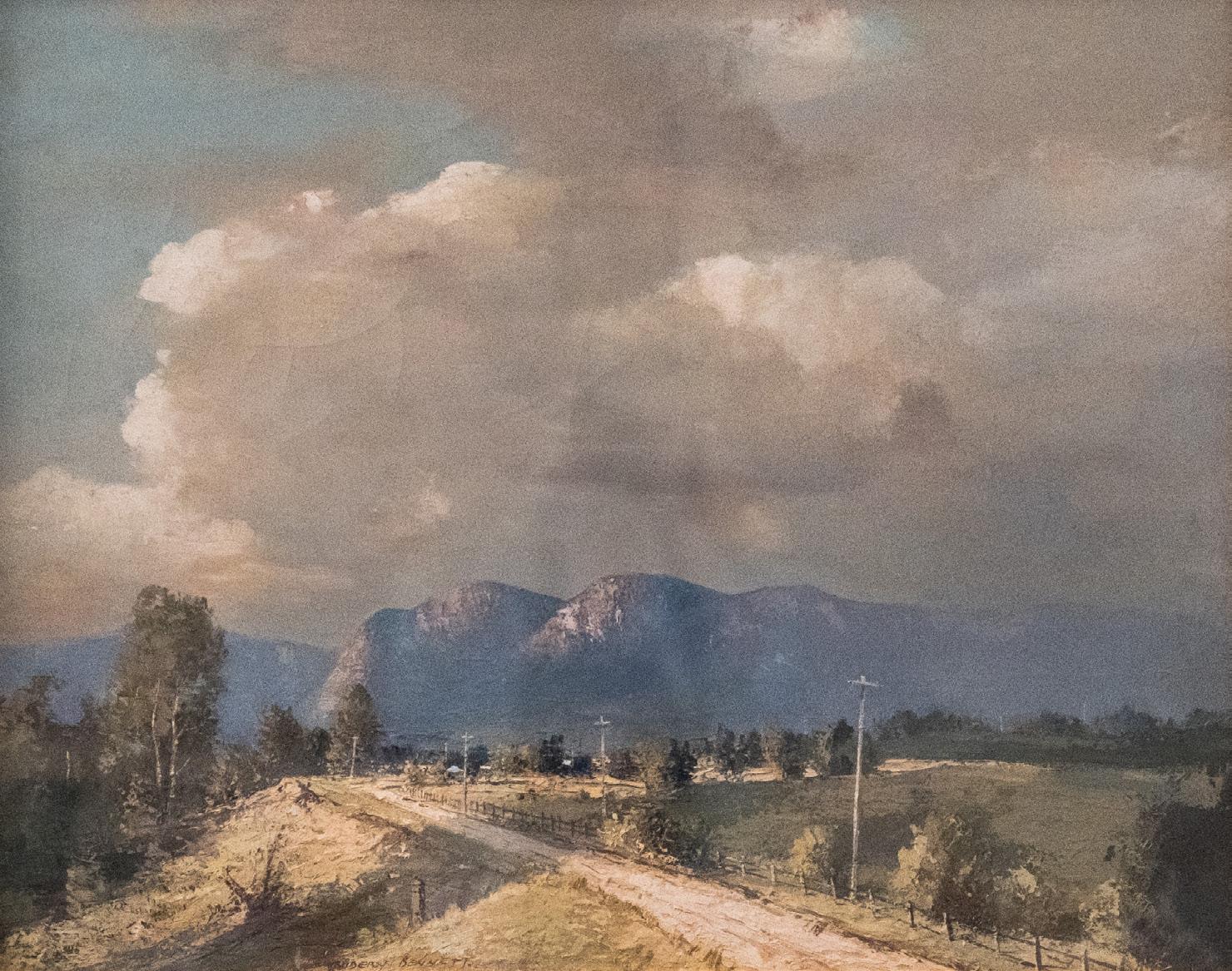
William “Rubery” Bennett
Born Clayfield, Brisbane, January 1893; died Sydney, 10 March 1987.
Storm Clouds Burragorang, c. 1940
Oil on canvas
Signed lower centre: “Rubery Bennett”
Provenance: Presented to the College by Una Porter in 1998.
Bennett admittedly holds less reverence in the Australian art world
consciousness of today than his Australian School contemporaries like Roberts and Streeton. During the artist’s life, Bennett gained renown for his ‘sensitive’ depictions of the Australian landscape, with three of his works being purchased by Queen Elizabeth II during her royal visit to the country in 1954.
The subject of Burragorang holds great significance to the artist. Bennett first visited the site in 1924 for a painting camp headed by Bennett’s longtime friend and mentor John Salvana.
Bennett then visited the Lower Burragorang ten years later with his wife, with this location becoming his preferred destination for painting for many years.
This affinity with the lower Burragorang later became a fleeting one, as the valley was decided to be the catchment site of the Warragamba Dam, which now serves as the primary water source for the Sydney region. The creation of the Dam inundated the Burragorang Valley, forcing out both the Gundungurra traditional owners of the region and residents of the small farming communities that populated the area, despite their fervent resistance to the loss of their home.
Bennett’s series of works that seek to faithfully document the area retrospectively serve as both blank and memorial to a region and community that was sacrificed to serve the needs of the urban constituents of New South Wales. This particular work depicting the beginnings of a storm emerging upon its environment deepen this sense of prophetic demise.
This work was held in the private collection of Una Porter prior to its arrival at St Hilda’s. The work was gifted to her by St Hilda’s councillor Alice Paton, with the agreement that the work would eventually be housed in the college after Porter no longer had use of it.

Born Malvern, Melbourne, 5 October 1924; died Melbourne, 10 June 2006
St Hilda’s College 1964, 1964
Watercolour on paper
Signed lower left: “Kenneth Jack 1964”
Provenance: Presented to Alice Paton by Council of St Hilda’s College in 1964, donated back to the Council upon Paton’s death.
A prolific painter throughout his life, Kenneth Jack is most known for his depictions of outback towns and landscapes. Thanks to Jack’s significant output, we have been given a faithful depiction of the evolving face of Melbourne and its surrounds, serving as an important historical record for future generations. Jack was honoured with an AM in 1987 and his work has been collected by Queen Elizabeth II, the National Gallery of Victoria among countless other institutions around the world. This work was commissioned by the College council during the height of Jack’s career as a gift to the founding force of St Hilda's Alice Paton, in commemoration of the College’s opening. The work was returned to the College following her passing.
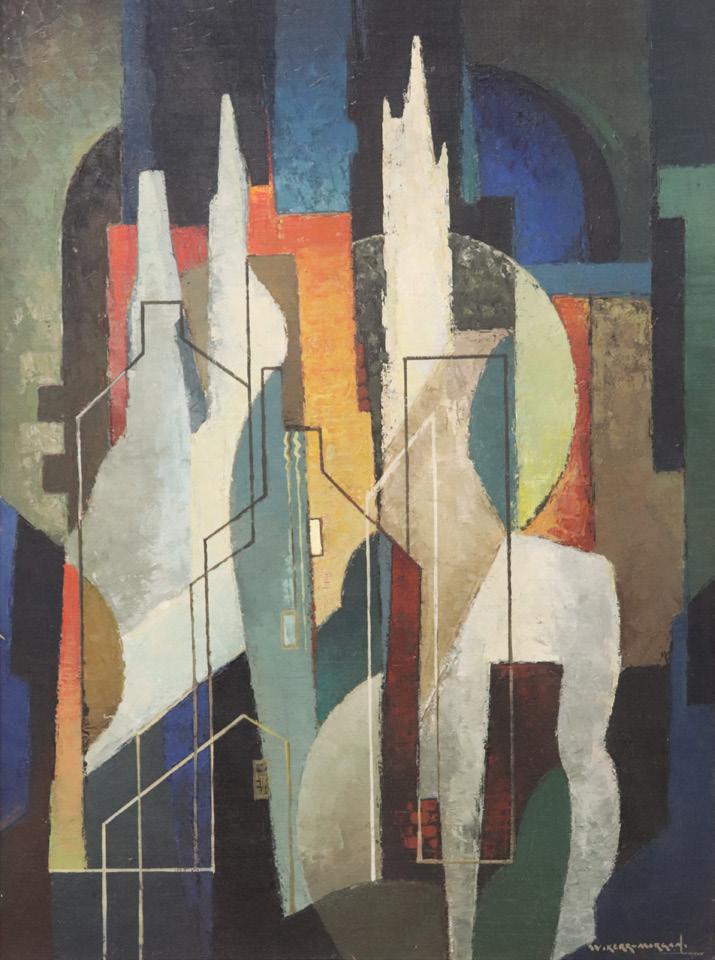
Born Craghead, England, 1896; died Melbourne, 1967.
Moon Serenade, c. 1960
Signed lower right: "W. Kerr-Morgan" Oil on canvas
Provenance: Presented to the College by the artist.
Kerr Morgan worked primarily as a stained-glass artist, creating works for Trinity College, and churches in Gardenvale and Balaclava whilst under the employ of firm Brooks Robsinson as their principal artist. Kerr-Morgan entered St Hilda’s history as the designer of the College Crest, and held an exhibition of works at the college in 1966, which is the suspected origin of this work.

II, 2015
Provenance: Presented to the College by Brenda Holt in 2022.
An artist by passion, Dalton-Brown is most known for her academic work, and previously held the title of Dean at Queens College Melbourne. During her tenure at Queen’s, Dalton Brown held an exhibition titled Picasso’s Dust. It was at this viewing that St Hilda’s Principal purchased this work. Redland II was previously housed in the Principal’s residence as part of Holt’s personal collection. Upon her retirement in 2022, Holt gifted the work to the college.
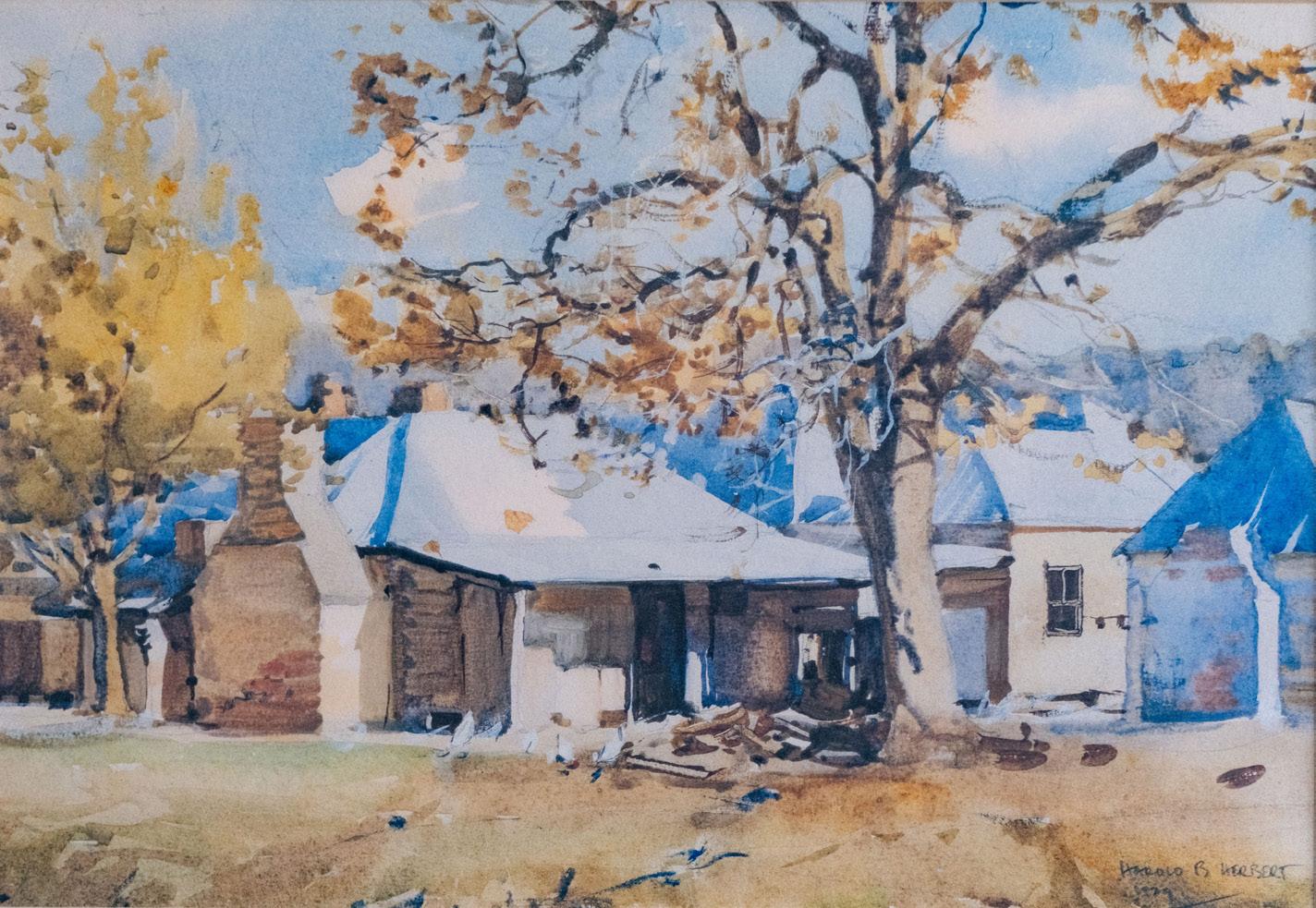
Born Ballarat, Victoria, 16 September 1891; died Melbourne, 11 February 1945.
Autumn Afternoon, 1929
Watercolour on paper
Signed lower left: “Harold B. Herbert 1929”.
Provenance: Thought to have entered the collection in the 1960s.
A student of the Australian Impressionist movement and a skilled watercolourist, Herbert was a traditionalist at heart, preferring naturalism and working in plein-air. Herbert was equally well-regarded in both his skill as an artist and local personality, and regularly exhibited alongside the likes of Arthur Streeton and John Longstaff. Herbert’s sketches and finishes watercolours are currently in the collections of the National Gallery of Victoria and Australian National Gallery and the Ian Potter Museum of Art. Herbert’s depiction of a homestead is typical of his style, demonstrating rich warm colours and dappled contrasts echoing the transitional season upon a familiar Australian neighbourhood.
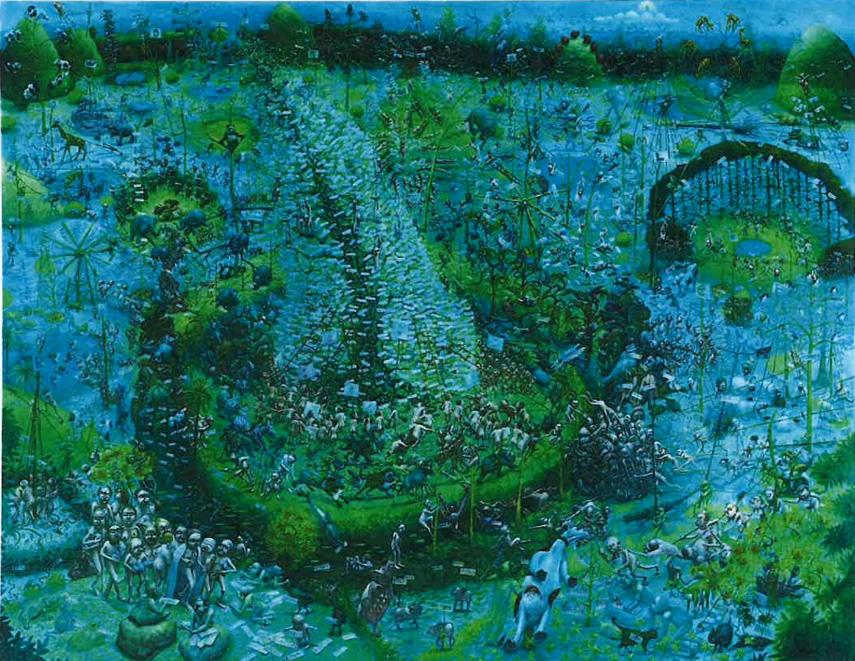
Hayes is known for creating ‘large-scale allegorical paintings’,
often with religious subject matter as part of a wider exploration of Australian identity. This work is typical of the artist’s oeuvre, depicting the narratively biblical foundations of the dictionary in a tongue-in-cheek manner.
This piece was donated by Robyn Bradbury in 2023. Robyn was a founding student of the college in 1964 and gifted the painting to celebrate the 60th anniversary of the opening of St Hilda’s. Robyn offers the following reflection:
“I came to the college just after it opened, when Mrs Smart was the Principal. She was a warm and gracious person, who had worldly experience and a deep commitment to student and world wellbeing. This painting is a way of expressing my gratitude to the college for a formative experience in my life.
The symbolism of the painting, for me, is that learning to speak from the self is integral to the formation of identity. The ‘words,’ to speak, come from the formation of our identity. It is this identity that enables us to mature through the lifespan and become enabled to function to be part of a community. To be an individual within a group is a most difficult accomplishment for human beings. We are primarily social animals, and to be separate from the herd is challenging. This painting demonstrates this movement through time. To find one’s path in life is therefore a balance between being an individual and being part of a group. Being part of a secure community may create a foundation for the safety to express individuality, and this is what life in college may provide. It did for me.
To serve a larger community, and to express one’s individuality is a lifelong program which involves language, communication, ethics, and a capacity to find a way through action to express oneself as a whole being, part of but separate from the group: this is our uniqueness as a human being.
This painting by Cameron Hayes describes the importance of finding the language of the self. I donated it as a way of expressing my belief in the broader bases of education as being to combine values and finding the language of oneself, as well as academic achievement. I believe the values of serving the community were nurtured by my experience in college, and I hope that this painting inspires others in their path for creating and valuing a personal identity and value system, as well as pursuing academic excellence.”


Based in Melbourne
Untitled (D), c. 2001
Pastel on board
Provenance: Acquired by the College on the recommendation of Barbara Green, Principal, in 2002 from Arts Project Australia.
This work was purchased from Arts Project Australia, an enterprise based in Melbourne that seeks to support and empower artists with intellectual disabilities through studio support and creative enrichment programs.
Born Wales, 1905; died Adelaide, 13 June 1987.
Cock Robin, 1968
Vitreous enamel on steel
Provenance: Thought to have entered the collection in the 1970s.
Hesling began his creative life in the theatre in London. Following his immigration to Australia in 1928, Hesling worked as a designer, writer, and cartoonist before turning to mural work. Outside of his career as a maker, Hesling had a brief stint as an art critic. Described as an eccentric and jovial cynic, Hesling is also remembered for his rivalry with fellow critic Robert Hughes following Hesling’s ousting from the Observer. His work with vitreous enamel, like Cock Robin, became his specialty when he pursued the medium in 1958. These often bold, lively works of abstraction earned Hesling national recognition, and is regarded as the Australian pioneer in the medium.
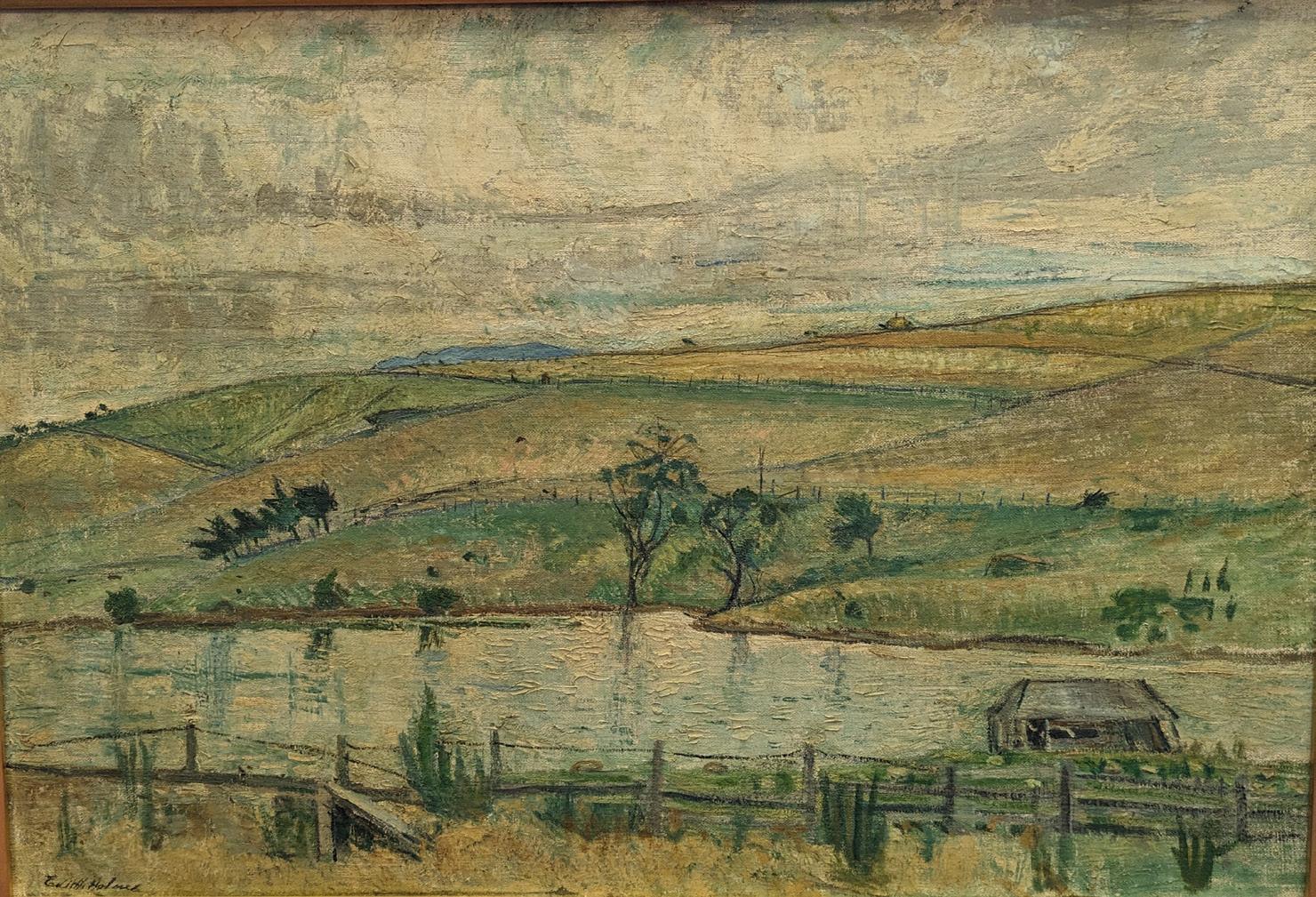
Born Hamilton, Tasmania, 9 March 1893; died Hobart, 26 August 1973.
Untitled, date unknown
Oil on canvas
Signed lower right: “Edith Holmes”
Provenance: Though to have entered the collection in the 1960s.
Acommitment and advocacy for Tasmanian art and its environment
s a founding member of the Tasmanian Group of Painters, Holmes’ distinguishes her from her contemporaries. Her chosen isolation amongst the Tasmanian mountains berthed a distinctive employ of colour and textured painterly strokes in an altogether ‘new’ flavour of modern art that was entirely her own. While some has regarded her as an eccentric due to her colour outfit and penchant for unique hats, Holmes preferred to call herself an ‘original’. Holmes specialised in still life and portraiture, and often secluded herself to an artist shack by the Carlton River, as seen in this work. This location, often featuring nearby Mount Direction, became a favourite of Holmes over her artistic life. Despite her isolation Holmes exhibited regularly, often travelling to do so, but always returning to her childhood home in Moonah, where she remained until her death in 1973.
Credited by her friends as a woman of wit and great sense of humour, Holmes was a very active member of society and strived for contentment in life as Hobart poet Viviant Smith recalls of the artist in her following verses:
I heard your living voice last night, Your voice that mixed so many styles and tones, An interview recorded before deathYou who detested wirelesses and phones.
“I’ve had small recognition but enough,” You said: “I live for colour and this place. See that lichen’s shawel spread on a rock.
For me the mountain has a human face, The hills an outline that is partly mine…”
Your curtain with a window shows a life
But what your epoch struggled for is found
In breakfast room with mountain, bread and knife.
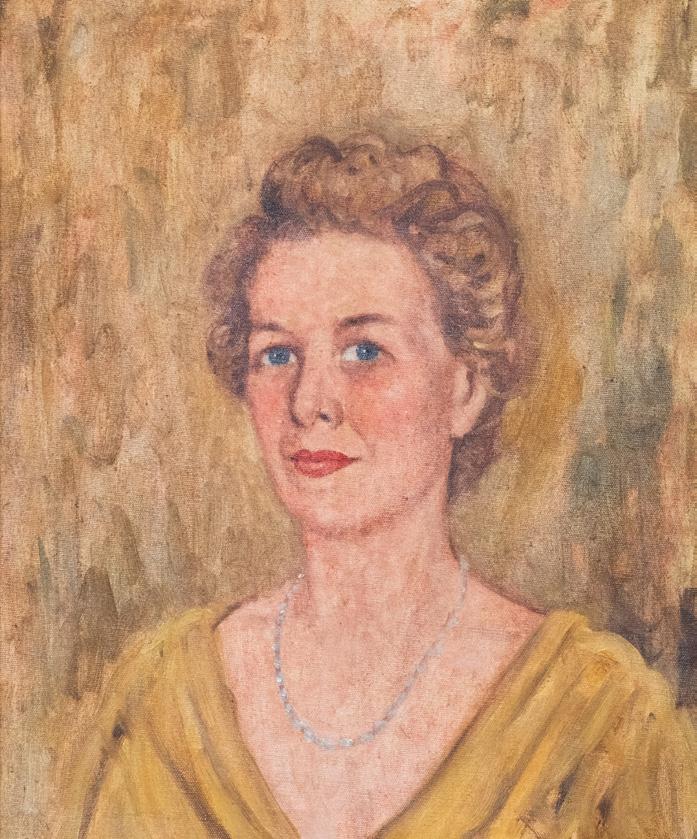
W. John Peisley
Born Bathurst, New South Wales, 1916; died 1997.
Marjorie Gordon Smart AM, 1954 Oil on canvas
Signed lower left: “Peisley NY 1954”
Provenance: Presented to the College by Elizabeth Jess-Paterson in 2004.

Peter Zageris
Born Germany, 1947; arrived Australia 1950.
Marjorie Gordon Smart AM, 1974 Oil on canvas
Provenance: Commissioned by the College council in 1974 in commemoration of the 10th anniversary of St Hilda’s, and unveiled by Sir Robert Menzies.
“Few young women will go in and out of a College over which Marjorie Smart presides without having their horizons widened.”
— Davis McCaughey
Born in Winnipeg, Canada, Marjorie emigrated to Melbourne in 1954
following her husband’s retirement. During this time Smart pursued her passion for education and community service through voluntary work at the University of Melbourne. As St Hilda’s inaugural Principal, Smart set the standard for Communitas, in creating a home away from home for Hilda’s first students, and often going beyond her official duties to do so. Her tenure also saw the beginnings of coeducation in 1973 and the construction of the Alice Paton Library, two residential blocks and the Una Porter Chapel block.
Born in Bathurst, artist W John Peisley migrated to New York in 1945. Peisley supported himself as a commercial portrait artist during this time, and this first portrait of Smart is a likely example of this work.
The second portrait was commissioned by the College in commemoration of the 10th anniversary of St Hilda’s establishment. Smart retired the following year, after having served 12 years at the college and firmly established the tone of St Hilda’s that helped “put St Hilda’s on the map”.
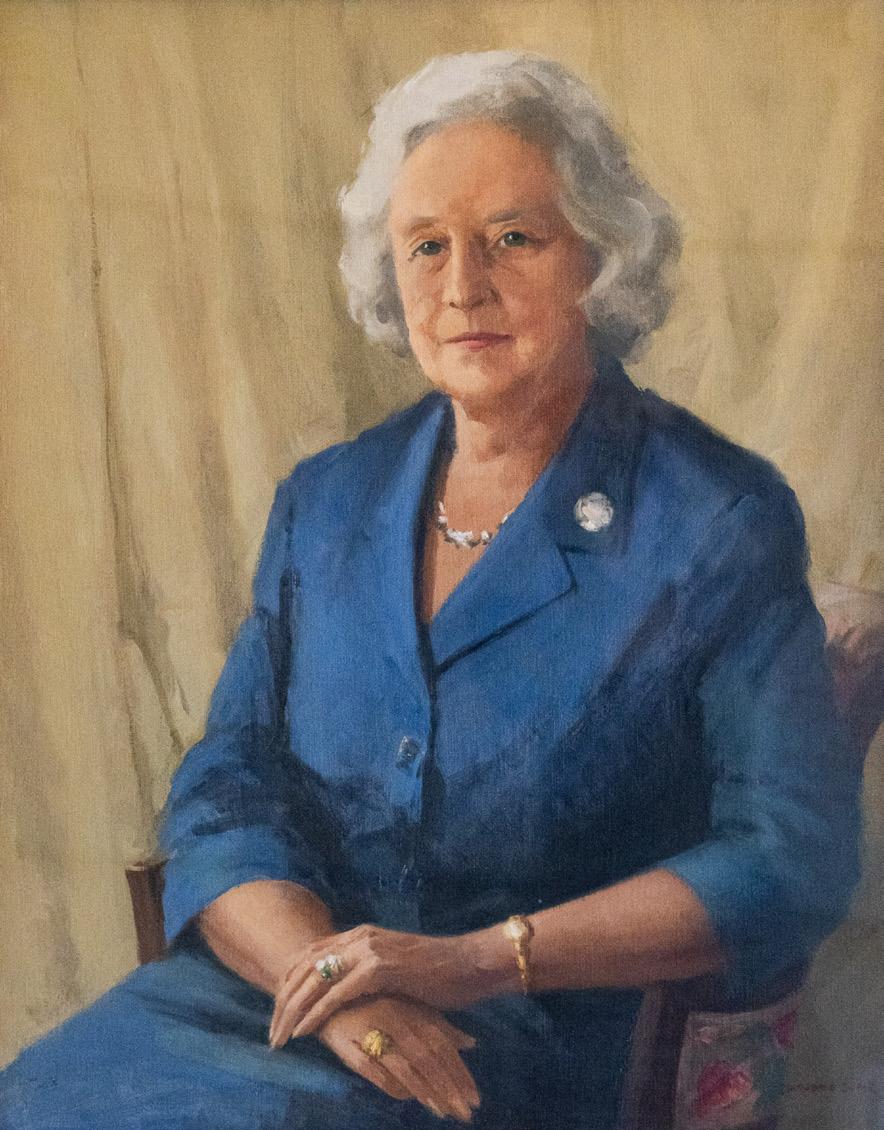
Active 1980s
Una B Porter, c. 1980
Oil on canvas
Signed lower right: “Marjorie Blair”
Provenance: Presented to the College by Desda Browne in 1983.
Born Una Beatrice Cato, Porter’s early life was marred by illness and she pursued tertiary education later in life. Her difficulties pursuing medical education as a woman led to Porter’s affiliation with Alice Paton and enthusiasm for the establishment of St Hilda’s Council, where she served as a founding council member from 1961 to 1975.
As a notably religious woman and generous philanthropist, Porter was a foremost advocate for the construction of a chapel at St Hilda’s College, donating $24,000 to the effort. The chapel was named the Una Porter Chapel in recognition of her gift. Her portrait, donated to the College by longtime companion Desda Browne, hangs in the Auditorium today, in memory of the room’s former life as the Chapel.
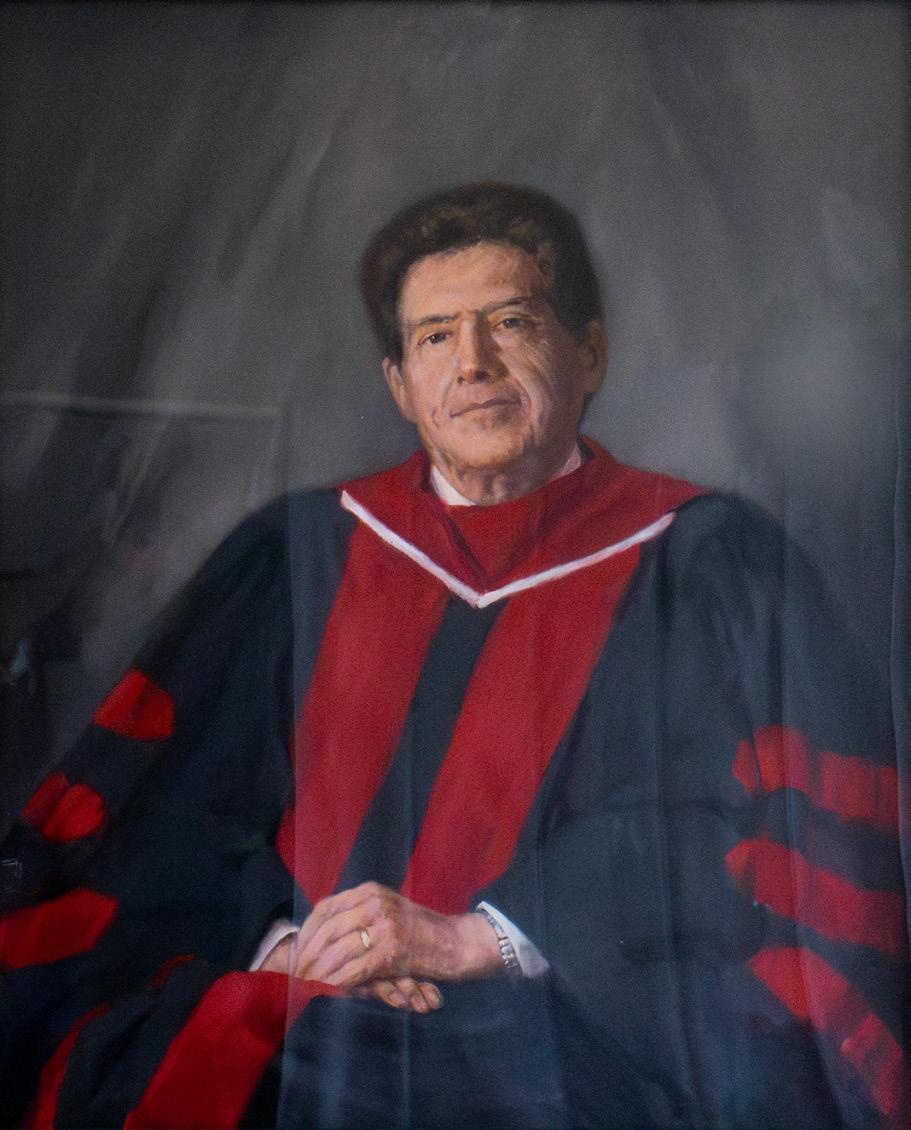
Dr Brian James, c. 1997 Oil on canvas
Provenance: Commissioned by the College c. 1997
Prior to his stewardship as St Hildas’ third principal, Brian James worked as a counsellor for the University of Melbourne. Known affectionately as “Doc” in recognition of his theological education and background, Dr James sought to continue in Smart’s legacy of dedicated service to students, instilling a values-based residential education at the College. His portrait presents Dr James in his religious garb, presenting his reverence for the faith-based practice he embedded into the fabric of the college.

Active 2003 —
Barbara Green AM, 2011
Oil on canvas
Signed lower right: “Dunlop”
Provenance: Commissioned by the College in 2011.
Barbara Green’s life at St Hilda’s began as a student, living at the college in 1975. She later joined the council before becoming St Hilda’s 5th principal, serving for 18 years. Green’s professional life has been characterised by her service to student life and education. This service was later recognized in 2020 when Green was appointed as a Member of the Order of Australia (AM) as part of the Queen’s Birthday Honours.

Active 2003 —
Dr Brenda Holt, 2022
Oil on canvas
Signed lower right: “Dunlop 22”
Provenance: Commissioned by the College in 2022.
Following an established career in enriching student life at colleges in Australia and internationally, Holt’s tenure at St Hilda’s oversaw a period of great challenge and perseverance. Holt sought to uplift the College’s credo of Communitas throughout the changing landscape of student accommodation and social upheaval brought about by the arrival of COVID-19 and the subsequent lockdowns that followed. Holt’s unwavering attitude and commitment to the College community kept enrolments high and reinvigorated student engagement with St Hilda’s. Holt also oversaw the evolution of the social wellness of St Hilda’s with the reworking of student conduct policies and programs that advocated and supported LGBTQ+ life on campus.

Born Kew, Victoria, 23 May 1891; died Heidelberg, Melbourne, 2 May 1961.
Marjorie Gordon Smart AM, c. 1958 Oil on canvas
Written on verso: “Marjorie Smart approx. 1958-69
Most likely at “BanFF” St Kilda Melbourne
Painted by Lt Gen. Edward Kenneth Smart”
Provenance: Presented to the College by Elizabeth Jess-Paterson in 2004.
This creation by Smart’s husband Kenneth was donated to the college by his grand-daughter Elizabeth

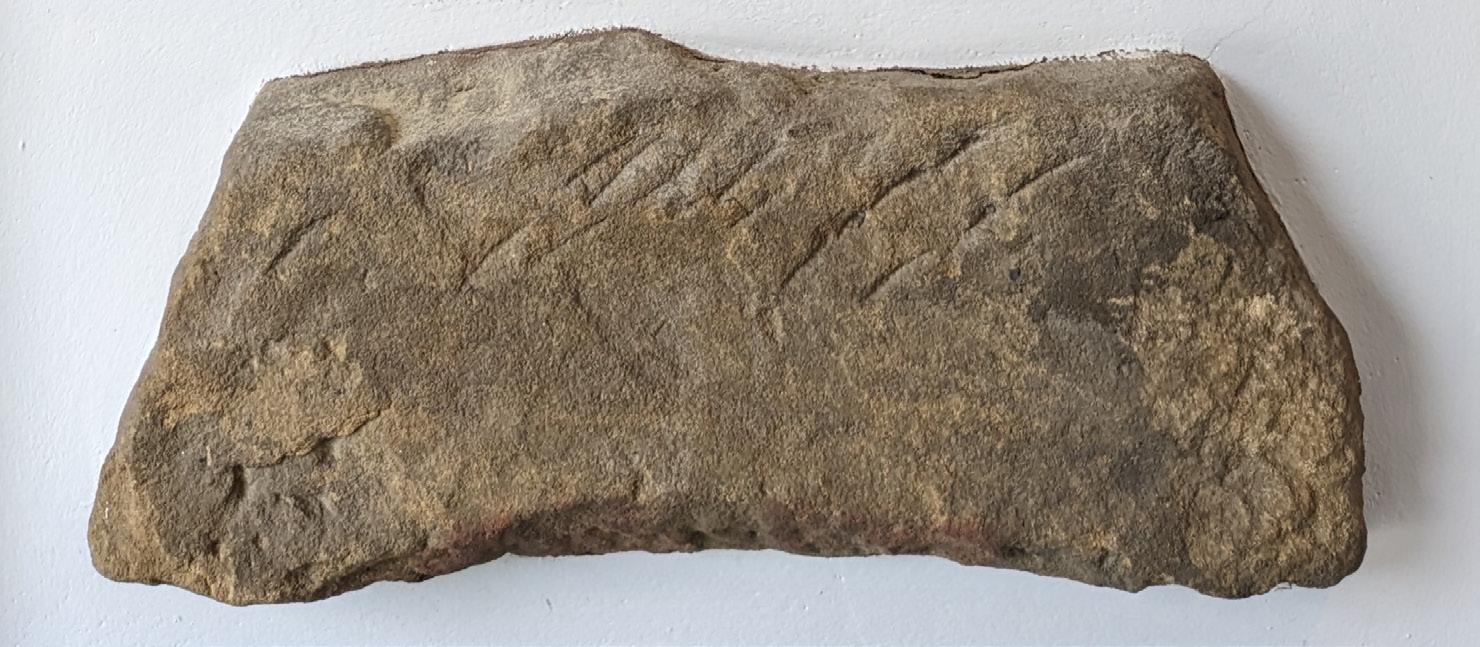
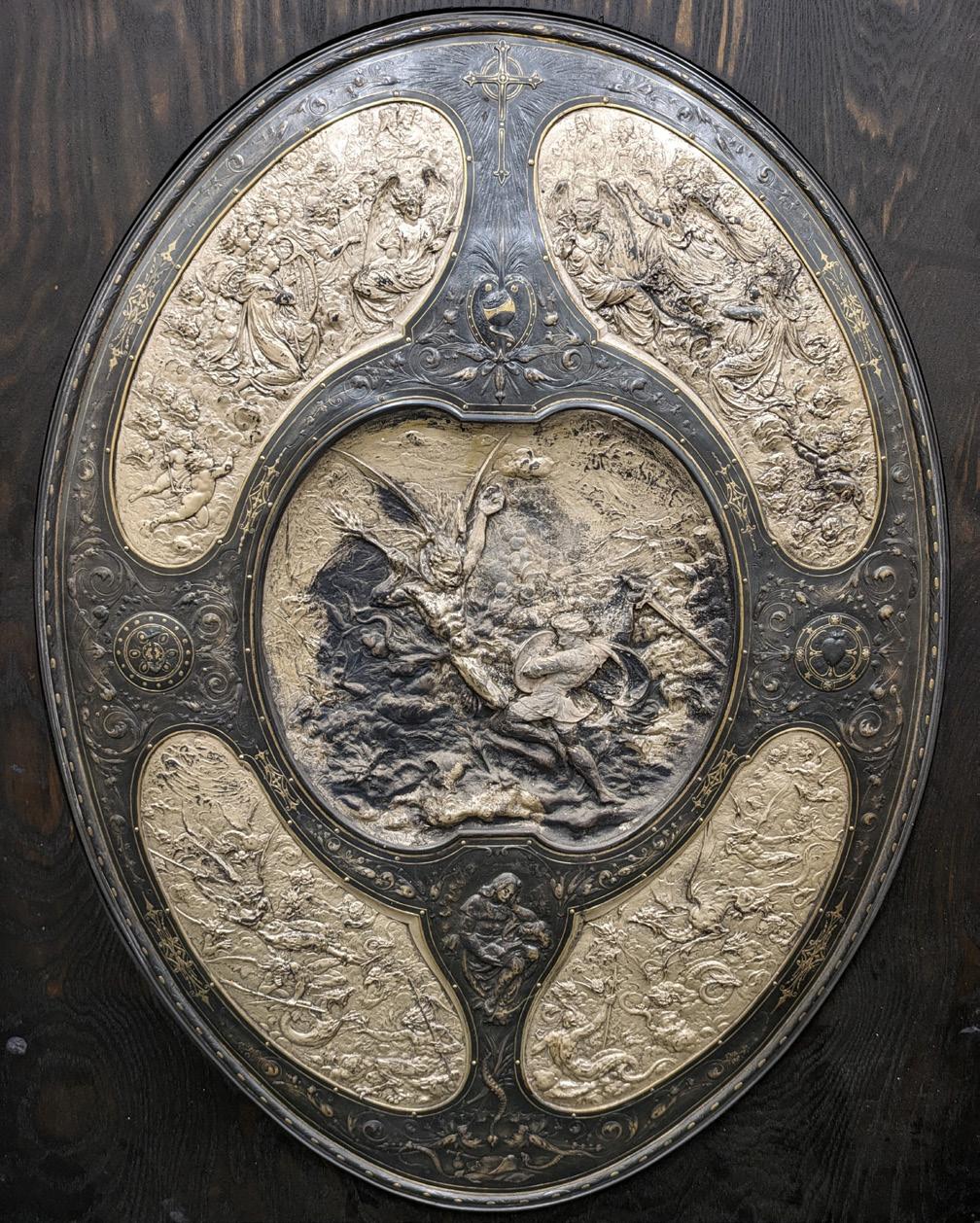
Founded c. 657 AD.
Provenance: Presented to the College by Professor Harold Woodruff in commemoration of St Hilda’s opening.
This stone comes from the ruins of the original Streaneshalch (now Whitby) Abbey, where Hilda of Whitby served as the founding abbess. As a monastery, Whitby housed monks and nuns alike, and became a significant religious site for the education of men and women. The abbey also holds religious significance as the site of the Synod of Whitby, a meeting to set the date for Easter.
Born Clermont-Ferrand, France, 1820; died Buulogne, 15 March 1888.
Active 1830 - 1963
Bunyan Shield, 1913
Oxide and gilt electrotype in Elkington Plate
Presented to the College by Lady Rivett in 1970s
The design on this shield depicts the journey of Christian pilgrims as told in John Bunyan’s 1678 work The Pilgrim’s Progress. This shield, crafted by Elkington and Co, is an electrotype (reproduction) of Leonard Morel-Ladeuil’s original, which was presented at the Paris Exhibition of 1878 to great acclaim. Similar electrotypes have been collected by noted institutions such as the Victoria and Albert Museum, and were highly sought after following the Paris Exhibition. The shield was donated by Lady Stella Rivett (formerly Deakin), a friend of the College in its early years. Following her death, Lady Rivett donated this shield, its papers and a sum of $1000, which began the Lady Rivett Bequest for purchasing books for the College library.
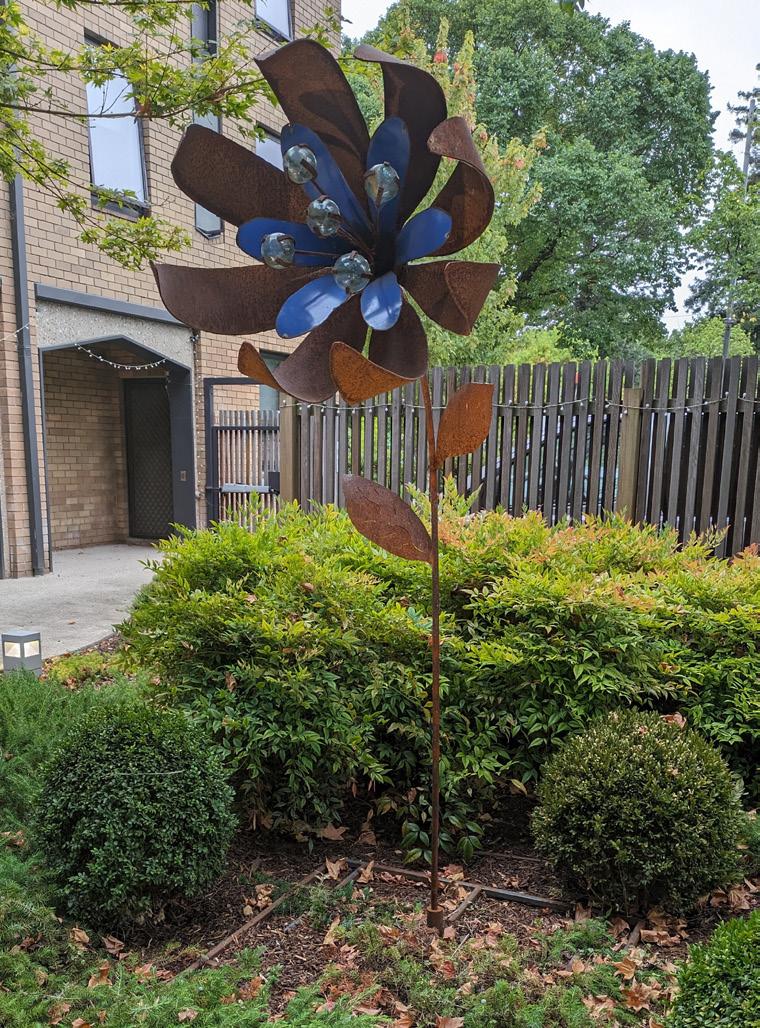
Active 2010s-present in Bend of Islands, Victoria.
Elsie, 2022
Recycled steel and Japanese glass
Provenance: Acquired by the Student Council in commemoration of Brenda Holt’s retirement from St Hilda's
In recognition of Principal Brenda Holt’s retirement from St Hilda’s, the Student Council acquired this work as a lasting tribute to Holt’s service to the college community. This work was unveiled at a farewell dinner held in Holt’s honour, along with a pair of bee earrings that reflected her nickname, “Brenda Bee”. The students specifically sought out a work that could be displayed outdoors that would enhance college life, just as Holt had done in her 5 years as Principal. Alumn and 2022 Student Club President Zara Williams had been instrumental in acquiring this work, and offered the following reflection on Holt’s tenure, and the work that commemorated it:
“I truly cannot imagine being at Hilda’s without Brenda, she took such great pride in us and care in looking after us. I hope Elsie brings some of the joy we all felt around Brenda to the college and that she looks back on her time with us, as turbulent as it may have been - COVID was a massive spanner in the works for us all - as fondly as her students do.”

Maker unknown, early 20th century Cedar
Provenance: Presented to the College by the Anderson/Taylor family in the 1960s.
This 20th century armoire came from the family of J Ringland Anderson, and was donated by the family in recognition of Mary Anderson’s (nee McComas) role in establishing the College in its early years. The armoire was most likely acquired by Ringland and Mary on their many travels through Asia, and is likely Chinese in origin. With the assistance of Mary’s grandchildren, the armoire was restored in 2004.
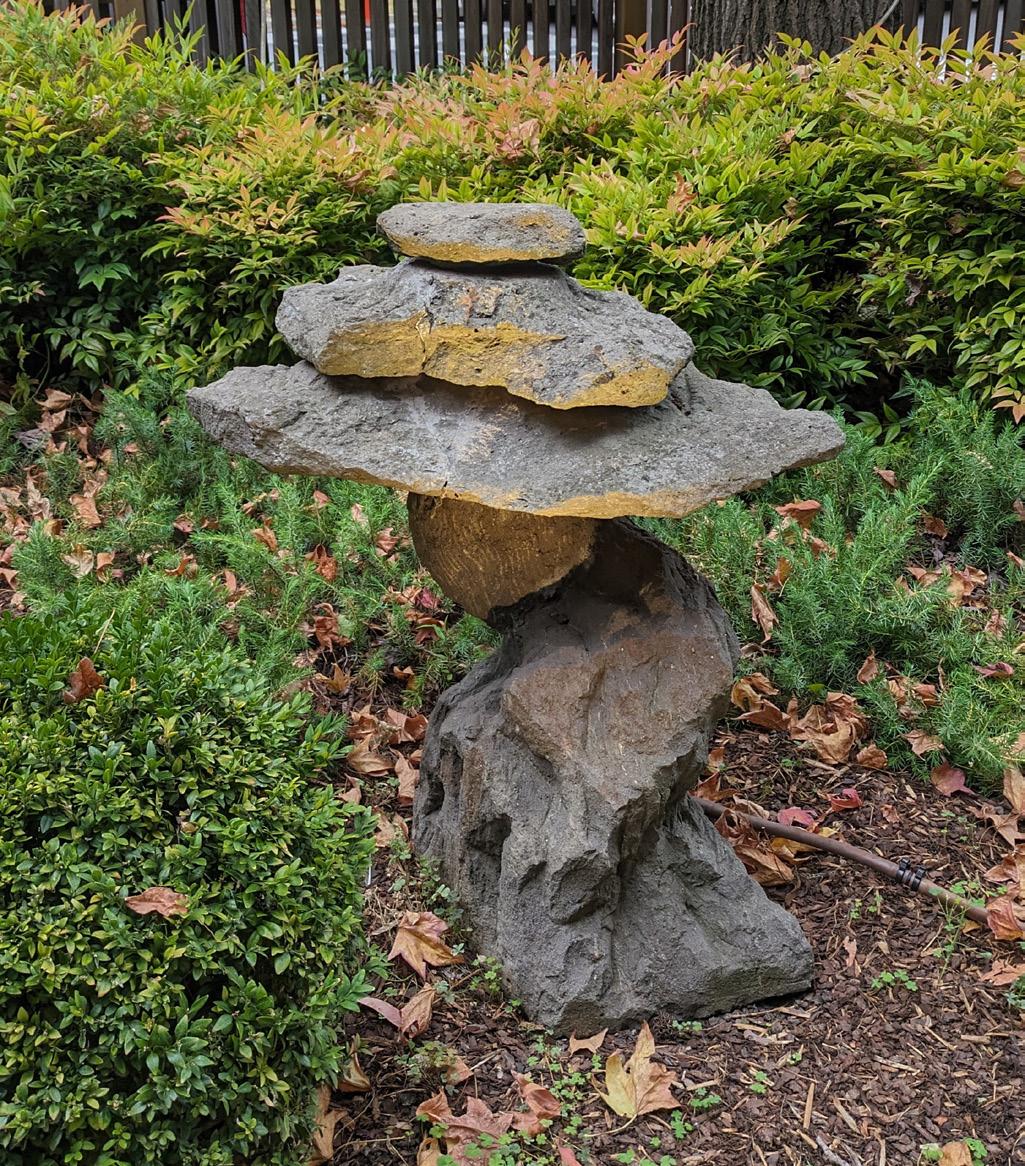
Born Bamberg, Germany, 1915; died Myrtleford, Victoria, 1988.
Title unknown, 1978
Stone
Provenance: Commissioned by the College in 1978 with the support of a College parent
Born in Germany, Knorr began working as a sculptor and cabinet maker in Victoria following his internment. Knorr lived and worked primarily in the Dandenongs, creating sculptures using wood, stone, and bronze and other mixed media. Achieving moderate success in his creative career, Knorr ran his own gallery in Emerald for a time, with his own works held in the collections of Gippsland, Wangaratta, and Geelong Galleries.

Born Brunswick, Victoria, 8 October 1928; died Melbourne, 10 January 2017. Library window, 1965
Stained glass
Provenance: Commissioned by the
Born in the then working-class suburb of Brunswick, French primarily worked as a signwriter and painter. French is more well-known for his stained-glass works, with his first work in the medium being the Great Hall ceiling in the National Gallery of Australia. While denying any association with religion personally, his artwork was deeply connected to spirituality, once claiming that “all art is religious”. References to religion are frequent in French’s work and can be seen in this window, as depicted in the fish at the lower pane and multiple crosses.

Born Auckland, New Zealand, 1912; died Victoria, Australia, 1997. St Hilda mosaic, 1964
Tesserae (Venetian glass enamel)
Provenance: Presented to the College by the artist in 1964 in memory of Jessie Madsen
Facing the Whitby Stone at the main entrance stands a mosaic in St Hilda’s likeness, constructed by Lorna Marion Waller. Waller was more known contemporarily for her work as assistant to her famous husband, Napier Waller, on his large-scale works that populated the City of Melbourne. Lorna was a close friend of architect Jessie Madsen, a figure that was central to St Hilda’s beginnings. Upon Madsen’s passing, Waller donated this work to the college in her memory, with the work being unveiled at the official opening of the college. A plaque acknowledging both Lorna’s work and Madsen’s legacy sits at the base of the work.
The Chapel-Common room block was a later addition to the college, opening in term three of 1968. This addition was long awaited by both students, who needed the additional space, and council members, who felt these spaces were integral to their community-building effort. Several council members were personally committed to this effort, and made significant donations to the building and furnishing of the chapel. The Chapel then became an important gathering space for students and alumni, with many services, memorials and weddings held over the years. While this space is no longer officially a consecrated Chapel, the Auditorium still functions as a significant space of meeting for the Hilda’s community, with orientation, workshops and musical rehearsals often taking place here.






Inscription on paten: “In Memory of My Parents
D.A.G & J.S. Grierson, Lorna Osborn”
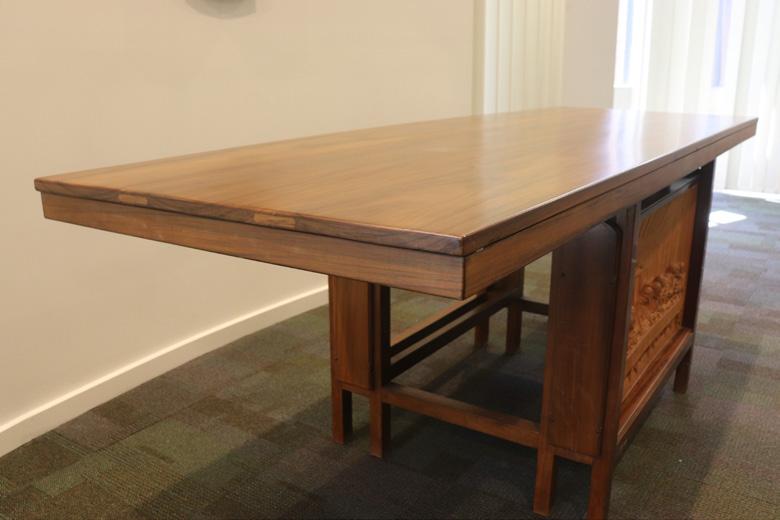
Born Bukovina, Romania, 28 July 1893; died St Kilda, Melbourne, 18 August 1971.
Communion table, 1969
Wood
Provenance: Commissioned by the College with the support of Jean Roberts in 1969.

Chapel lectern, 1969
Wood
Provenance: Commissioned by the College with the support of Jean Roberts in 1969.

maker unknown
Provenance: Presented to the College by Una Porter in 1969
This carving comes from Oberammergau in Bavaria, Germany. Oberammergau has a long tradition of woodcarving, and is home to the state’s woodcarving school. Additionally the town is known for its trompe l’oeil style frescoes that adorn the many buildings and homes in the area, often depicting religious scenes or those from mythology or fairy tales.
Krimper’s woodworking craft began at a very young age, having first apprenticed in his native Germany at 12 years old. When Krimper arrived in Australia as a refugee following the outbreak of WWII his skills as a cabinet maker were already well established. In Melbourne he was regarded as the premier craftsman of modern high quality furniture during the 50s and 60s. His mastery of timbers was held in the same esteem for his woodworking as fine artists and sculptors, with a number of his projects held in the National Gallery of Victoria.
This particular piece was once owned by Una Porter, and was displayed in a chapel she erected in her parents' memory on her Olinda property. When the chapel was destroyed in a bushfire, Porter chose to donate the carving to the college, where it was installed in Krimper’s communion table commission.

maker unknown, 1968
Sterling silver
Inscription centre: “Ordination May 26, 1968”
Provenance: Presented to the College by Dr Brian James in 1997 upon his retirement
This plate was awarded to Doc James upon his ordination in the US, and was gifted to the college upon his retirement as Principal.


Ronald Sharp


Chapel Cross
maker unknown, c. 1980s
Provenance: Possibly commissioned by the College in the 1980s. Wood
Born Kogarah, Sydney, 8 August 1929; died Sydney, 21 July 2021.
Chapel Organ, 1961-4
Provenance: Acquired by the College with the support of Lorna Lloyd Green in 1971.
Sharp’s output of organs was small in size, only 17 throughout his 30-year career. While small in output, Sharp’s work was certainly significant, having built organs for the Sydney Opera House, ABC Ultimo and Perth Concert Hall.
This organ was originally housed in the Our Lady of Consolation Home, run by the Franciscan Missionaries of Mary. Following the refurbishment and expansion of accommodation at the Home in the 1960s, St Hilda’s acquired the organ with the assistance of Lorna Lloyd Green.
Since arriving at St Hilda’s, the Sharp has been the perfect accompaniment to a number of college events over the years, most notably a recorded performance by musician Sergio de Pieri entitled Musica Antiqua.
The following works were created by students and friends of the College and have since become part of the St Hilda’s art collection. It is in this part of the collection where the creed of Communitas is more clearly seen; with works created for the College, to represent the College, as seen by the community that lived within it.
A number of works in this section of the Collection were created by 2021 alumni Mali Gordon, amidst the Covid-19 lockdowns. She offered this reflection on her work and artistic process in this excerpt of the 2020-2021 Chronicle:
Mali moved to Hilda’s in 2020, and studies Graphic Design and Art History at the University of Melbourne. In her second year, Mali was elected as the GC Arts Convenor. In this role, she aimed to start a culture where the fine arts are valued, and where people who may have had less exporsure to art could appreciate it.
...It was with this in mind that she saw creating a mural for the Hilda’s community as a perfect starting point.
“When I think of College, I thInk of dancing with everyone and having a good time. I wanted to encapsulate that feeling into the mural.”

Mali Gordon
Born 2001, St Hilda’s resident 2020-21
Music Room Mural, 2021
Provenance: Commissioned by the College in 2021
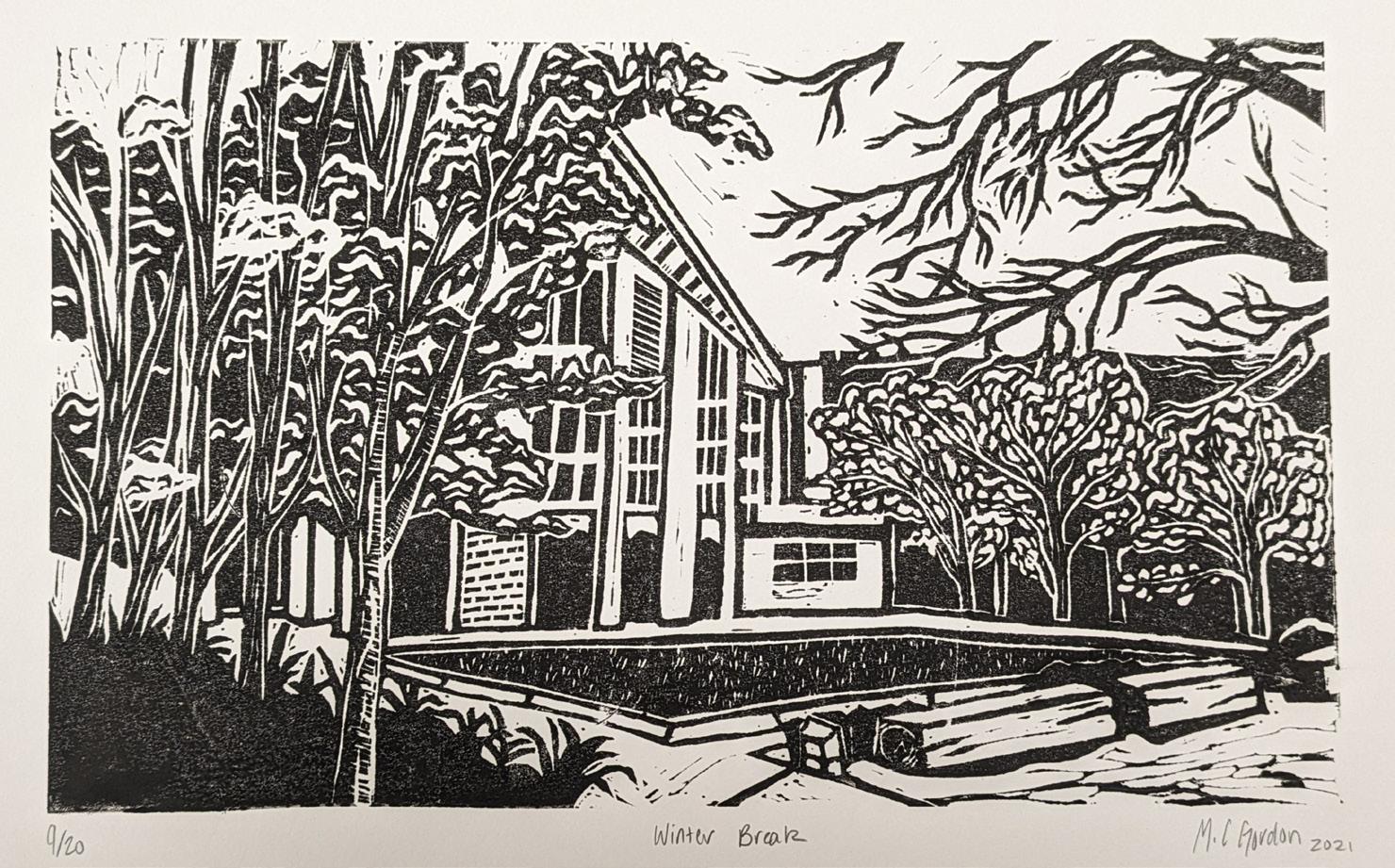
Gordon
Born 2001, St Hilda’s resident 2020-21 Winter Break, 2021
Print on paper
Signed lower right: “M.C. Gordon 2021” print no. 9/20
Provenance: Commissioned by the College in 2021

St Hilda's Senior Common Room President 2021
Still Life with Vegemite, 2020
Oil on canvas
Signed lower right: “CP”
Provenance: Commissioned by the College in 2020

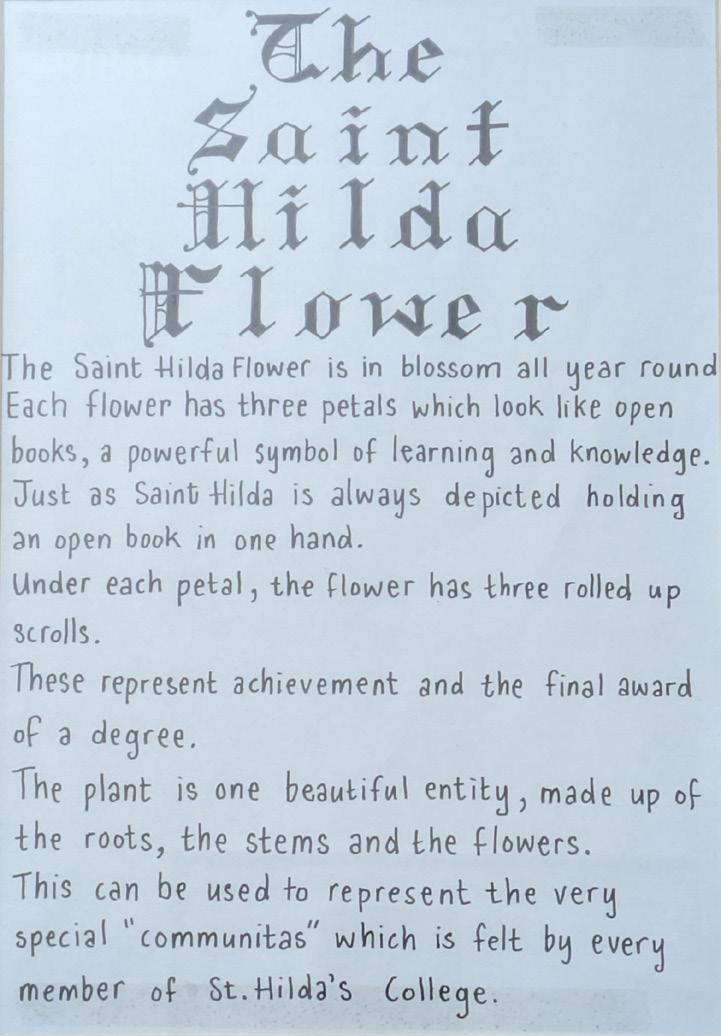


Born 2001, St Hilda’s resident 2020-21 untitled (Monstera), 2021
Watercolour on paper
Signed lower right: “M. Gordon 2021”
Provenance: Commissioned by the College in 2021
Born 2001, St Hilda’s resident 2020-21 untitled (Syngonium), 2021
Watercolour on paper
Signed lower right: “M. Gordon 2021”
Provenance: Commissioned by the College in 2021
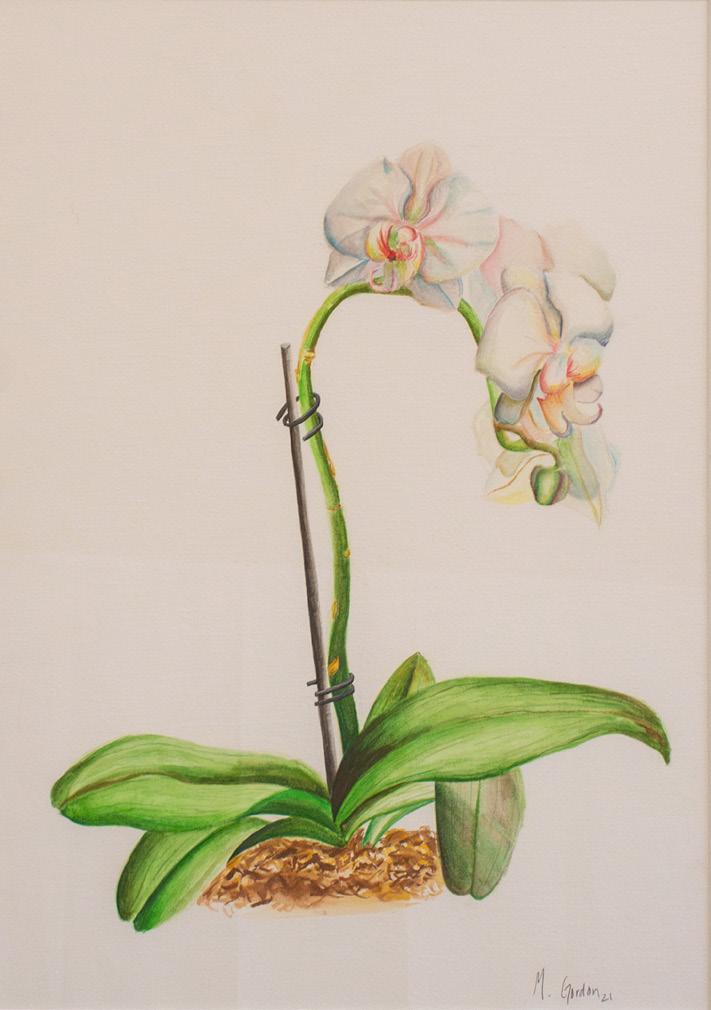
Mali Gordon
Born 2001, St Hilda’s resident 2020-21 untitled (Orchid), 2021
Watercolour on paper
Signed lower right: “M. Gordon 2021”
Provenance: Commissioned by the College in 2021

Tara Tiffin
St Hilda’s resident 2024
A Spring Afternoon at Hilda’s, 2024
Watercolour on paper
Signed lower right: “Tara Tiffin”
Provenance: Presented to the College by the artist in 2024
This work entered the collection as the winner of the 2024 Art Prize. The artist, student Tara Tiffin, offers the following reflection:
“This piece was inspired by seeing St Hilda’s enjoy the sunny days brought by the onset of Spirng. Under the new growth on the trees, many people are shown basking in the afternoon sun on the Front Quad lawn while reading, sleeping and studying with friends. I wanted to encapsulate the relaxed, friendly and Communitas-centred atmosphere of St Hilda’s by capturing this beautiful moment in time.”

Provenance: Acquired by the College in 2020
This series of works form the college’s Indigenous Collection, as we pay
tribute to the Traditional Owners of the site where St Hilda’s now stands, which began its long history as traditional birthing lands for the Wurundjeri people.
This chapter of the collection began during Brenda Holt’s tenure as principal, who sought to honour the Traditional Owners as part of the College’s wider Reconciliation effort. The first acquisitions of Indigenous art are notably created by Indigenous women, in recognition of the College’s site as a traditional space for women as birthing lands. Holt saw these acquisitions as an opportunity to educate the residents of the College, and spark conversations around the history of Indigenous Australia and what collectively we must do in the future to honour and make reparations for.
Many of these works are on display in the Communitas lounge, a space for students to come together and connect, and may be inspired by the imagery on its walls.
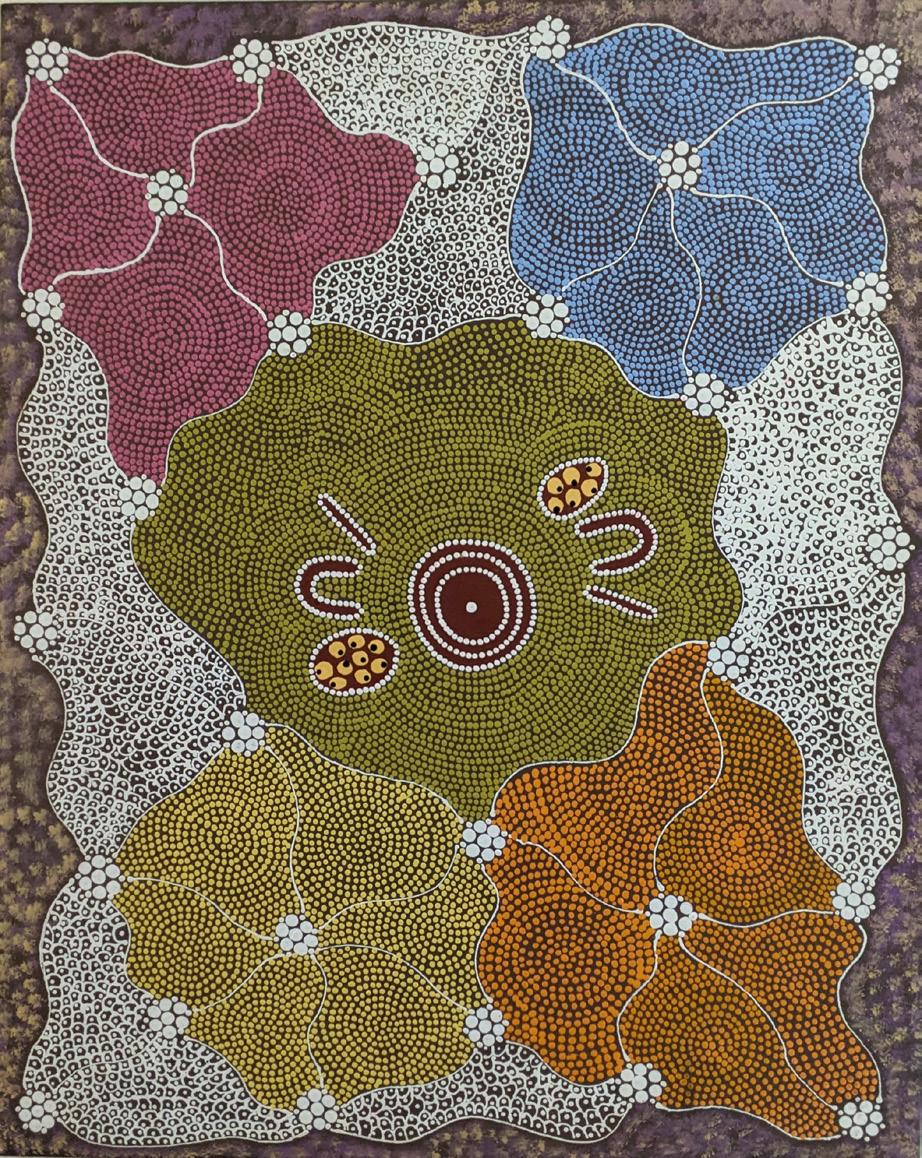
Kathy Napangardi Bagot
Born Yuendumu Country, Northern Territory, 1960s (Walpiri)
Ngapa Jukurrpa (Water Dreaming) - Puyurru, 2021
Acrylic on linen
Inscription verso: “Kathy Napangardi Bagot Warlukurlangu Artists 76 x 61 cm 1749/22”
Provenance: Acquired by the College in 2022

Born Yuendumu Country, Northern Territory, 1980
unknown (possible: Yankirri Jukurrpa (Emu Dreaming), 2022
Acrylic on linen
Inscription verso: “Pauline Nampjinpa Singelton Warlukurlangu Artists 122 x 71 cm 975/22” Pauline Nampjinpa Singleton
Provenance: Acquired by the College in 2022
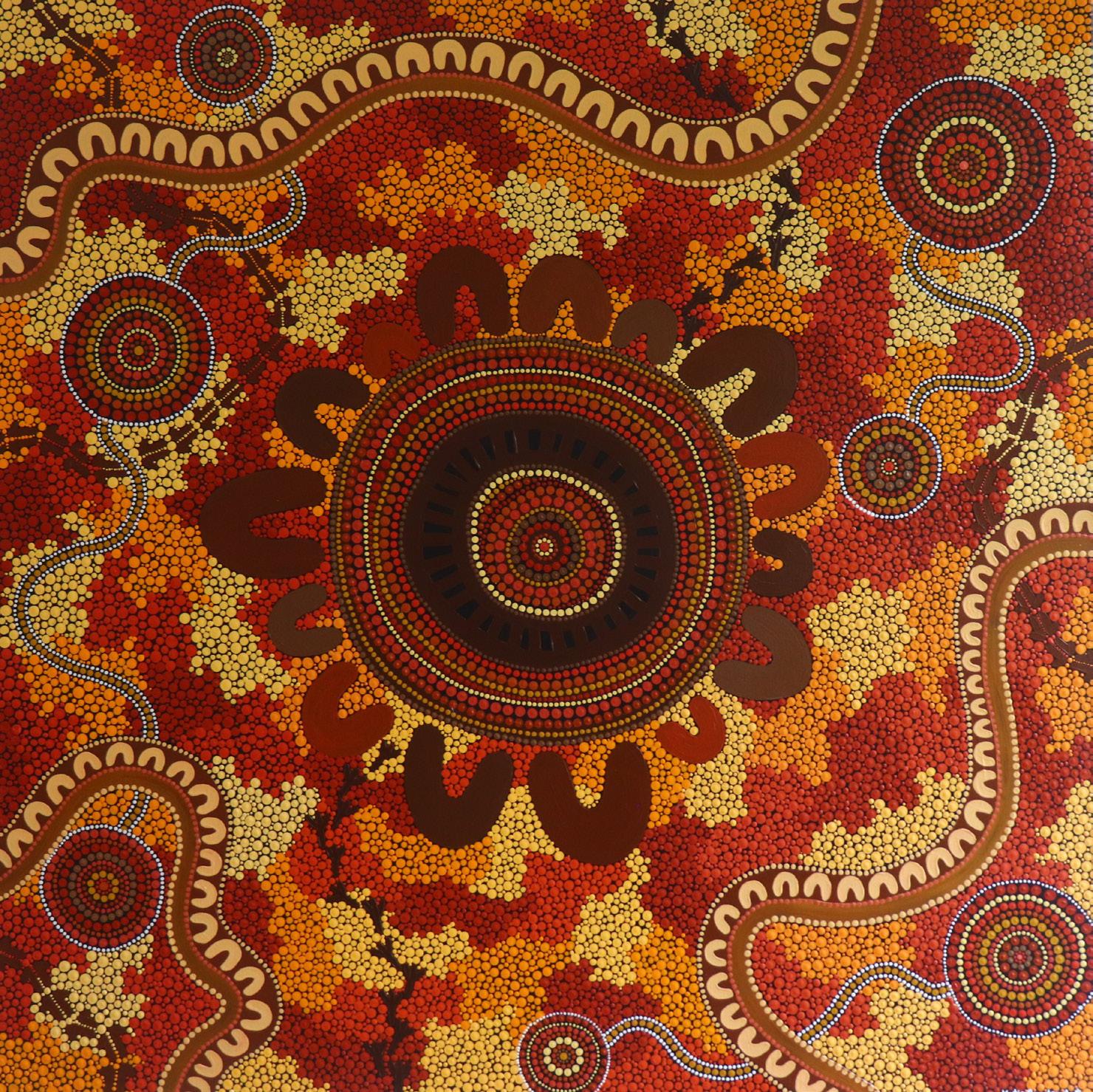
Born Bundjalung Country (Kamilaroi) untitled, 2021
on canvas
Provenance: Commissioned by the College in 2021
This work was commissioned by the College with the assistance of Arts Convenor Mali Gordon and Brenda Holt in 2021. For this commission, Gordon and Holt sought out an artist that was Indigenous and based in Naarm (Melbourne). Bugden, the artist, was commissioned to create a work that responded to the Hilda’s creed of “Communitas”.

T“My first major position [working in the Kimberley] was to set up psychological services in the region as there were none at that stage. In order to do this I needed to travel throughout the region and meet people. As a result of this experience I became acquainted with the various styles of each region - divided into East and West Kimberley but with many communities, each with their own language and identity. During this time and subsequently, I got to know many people and from time to time bought paintings from individuals if I could. Each of the paintings in this collection represents an aspect of identity which struck me at the time - something ineffable about what was being expressed. I’m not an expert on art - the appeal was entirely personal. The artists whose paintings I acquired mostly were people from remote communities and many of them had little or no formal education. The painting tells an aspect of their story.”
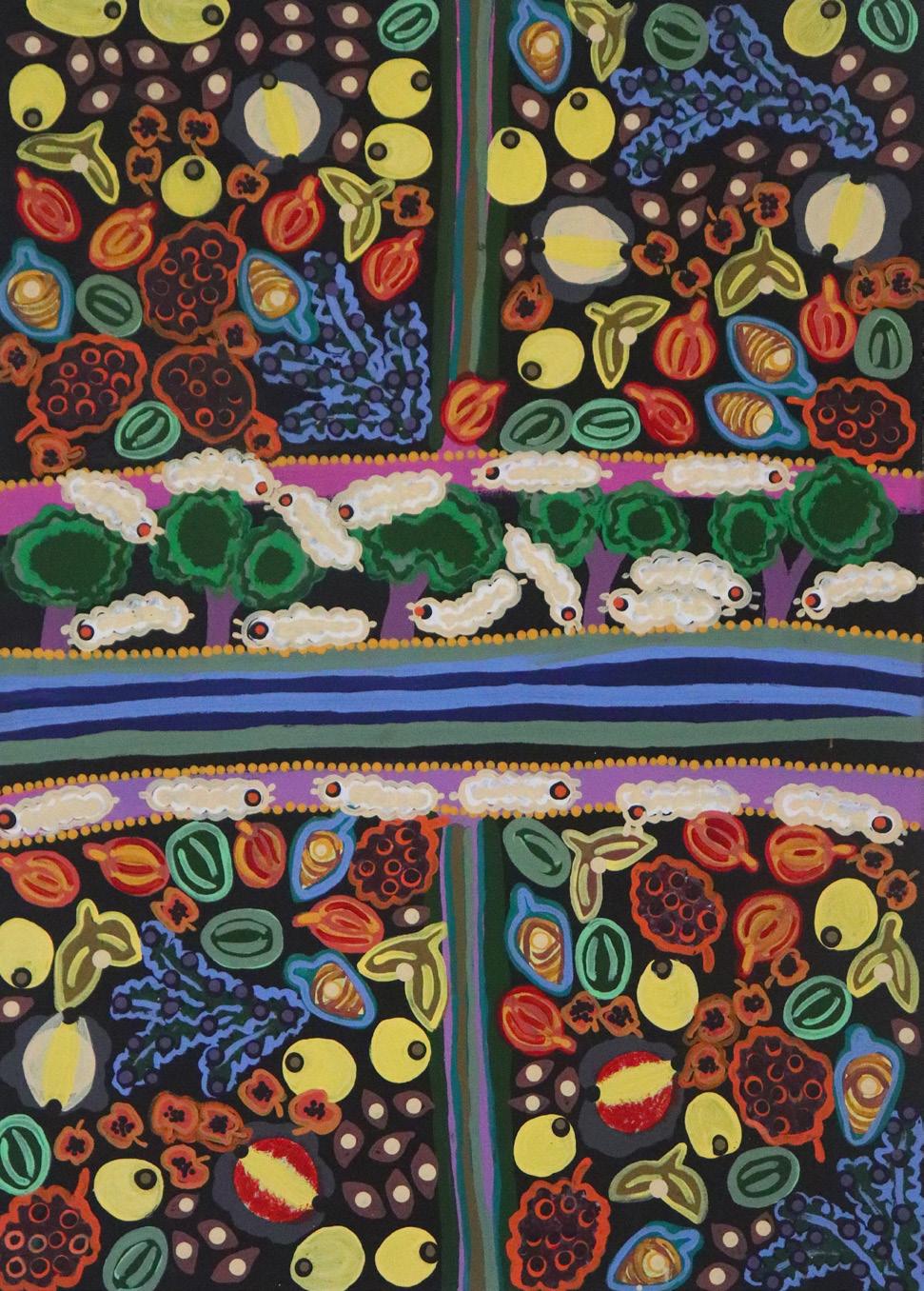
untitled,
signed verso: “Andrea Pindan”


I would like to express my deepest gratitude to Kate Abraham, Carly Damen, Carol Briggs, Elizabeth Stevens, and Annika Rasmussen for the time, advice, and labour they have given to this project.
I would also like to extend my thanks to Suzanne Spunner and Fiona Salmon for providing their support and expertise.
I am exceedingly grateful to Brenda Holt, Barbara Green and Brian James for their thoughtful conversation and memories they happily shared. Lastly, this project would not have been possible without the generosity and enthusiasm of the St Hilda’s community, which I have had the pleasure of witnessing through endless moments of kindness. These kindnesses have spanned the simple act of replying to an email, imparting a story, or donating an artwork. Together this community has been a constant source of inspiration. So thank you.
Pascalle Bailey, 2024.
Prisoner, date unknown
